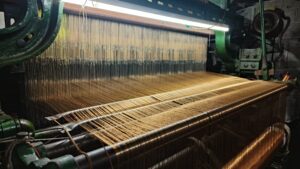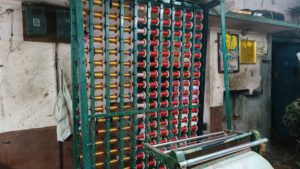Handloom is a metaphor for a slower, more rooted India. And like many other traditional crafts, it now exists on the edges of economic and social systems that prioritise speed and scalability.
Published Jun 07, 2025 | 12:00 PM ⚊ Updated Jun 07, 2025 | 12:00 PM

Each handwoven fabric has a story waiting not just to be worn, but to be heard in silence.
Synopsis: Once a weavers’ haven, Suddaguntepalya in South Bengaluru is now a bustling neighbourhood that keeps pace with the growing city. However, the weavers have to pay the price as they were sidelined and displaced, with the craft itself staring at a bleak future.
In the heart of South Bengaluru is Suddaguntepalya, locally known as SG Palya, a neighbourhood pulsating with the energy of student cafes, PG accommodations, corporate cabs, and street food stalls. But beneath this dynamic surface lies a quieter, delicate story — of looms, legacy, and loss.
For decades, this area was more than just a residential pocket. It was a woven neighbourhood, its lanes echoing with the rhythmic clatter of looms, its homes bonded with thread, texture, and tradition. Today, only a few of these past survive in quiet resilience.
The transformation of Suddaguntepalya is a classic story of urban development swallowing the artisanal. “This entire area used to be dedicated to weaving,” says Ramaswamy, who owns one of the last few loom sheds still functioning in the locality.

The looms of SG Palya are gradually falling silent.
“In the 1990s, you could walk down the street and hear looms in every house. Now, there are just four or five units left,” he adds with an air of resignation.
From 1995 to 1998, Suddaguntepalya was one of many weaving strongholds in Bengaluru. The accessibility to textile markets, easy access to raw materials, and a supportive local ecosystem helped handloom and power loom workers thrive.
But as the city expanded and real estate values rose, weavers’ neighborhoods began to disappear. They were pushed to the margins in favour of hostels, IT offices, and commercial buildings.
“We didn’t even realise how fast it changed,” says Ramaswamy. “One day, our neighbour was a weaver. Next, his place was a paying guest facility.”
For Murugesh and Mallesh, two middle-aged weavers who have spent over 20 years in the craft, weaving is not just a livelihood; it is an identity. They speak of power looms and handlooms not as machines, but as companions.

The younger generation are seeking more sustainable livelihood.
“A power loom can complete a saree in one day,” Murugesh says, “but a handloom takes its time. Two, sometimes three days. Yet there is something that feels right in that slowness.”
The handloom process demands attention and patience that have been passed down through generations. But now, it is at the risk of disappearing.
They recall a time when children in the area grew up watching their parents weave, slowly picking up the skill. But that chain is breaking. “Our children have no interest in weaving,” Mallesh says. “They see the city around and want to be a part of that world.”
It is a reality. With low job security, long hours, and limited visibility, traditional weaving no longer holds the same charm it once did. “They want office jobs, computers, cafes,” Mallesh smiles. “We can’t blame them.”
But what is lost when handloom culture fades? It’s not just a technique, it’s an entire language of living. Every woven saree carries within it a story of the weaver’s choices, of the region’s design heritage, of the crafted flow of manual labour.
Unlike mass-produced fabrics, handwoven sarees bear the marks of human touch, the small imperfections, the delicate tensions, the intimate colours.
In many ways, the handloom is a metaphor for a slower, more rooted India. And like many other traditional crafts, it now exists on the edges of economic and social systems that prioritise speed and scalability.
Suddaguntepalya’s handloom crisis is not isolated. Across India, from Varanasi to Chanderi to Pochampally, loom-based communities face similar struggles. What makes Suddaguntepalya’s story unique is its location: Right inside one of India’s fastest-growing metros. It becomes a parable of contrast between the past and the future, between craftsmanship and commercialism, between silence and speed.
In cities like Bengaluru, conversations around urban growth often center on infrastructure, tech innovation, and real estate. Rarely do they account for the silent industries like weaving that form the city’s invisible labour force.
“We didn’t move to the outskirts, but a lot of others did,” says Ramaswamy. Areas like Anekal, Gottigere, and Kanakapura Road are now home to many former SG Palya weavers, forced to seek space and silence outside the increasingly noisy and expensive urban core.
But relocation comes with a cost. Distance from traditional customer bases, lack of recognition, and weakening community networks all contribute to the decline of the industry.
A lingering question crops up during every conversation, around every loom, and within each unfinished saree: Will this survive another generation?
The answer is complex. On one hand, the next generation is better educated, digitally sharper, and eager to escape the limitations of manual labour. On the other hand, there is a growing interest, at least in urban elite circles, for sustainable, handcrafted fashion.
Initiatives that support handloom groups, design collaborations, and e-commerce platforms do exist, but the reach is still
uneven. “We need recognition,” says Murugesh. “We need space. We need the city to remember us.”
Suddaguntepalya may no longer reverberate with the daily sounds of looms, but its story is far from over. In the face of silence, weavers like Murugesh, Mallesh, and Ramaswamy continue to hold on not just to thread and cloth, but to identity, history, and dignity.
If Bengaluru is to truly call itself a city of diversity and design, then it must acknowledge the threads that lie beneath its glass buildings and glowing signboards. Because in every handwoven saree, there is a story waiting not just to be worn, but to be heard in silence.
(Edited by Majnu Babu).
